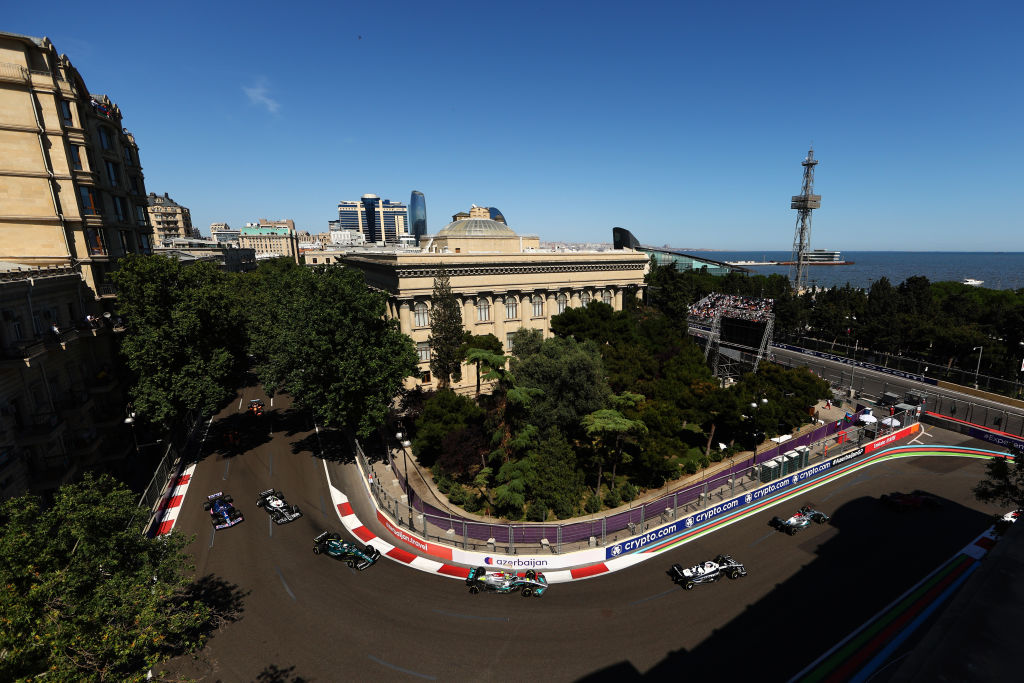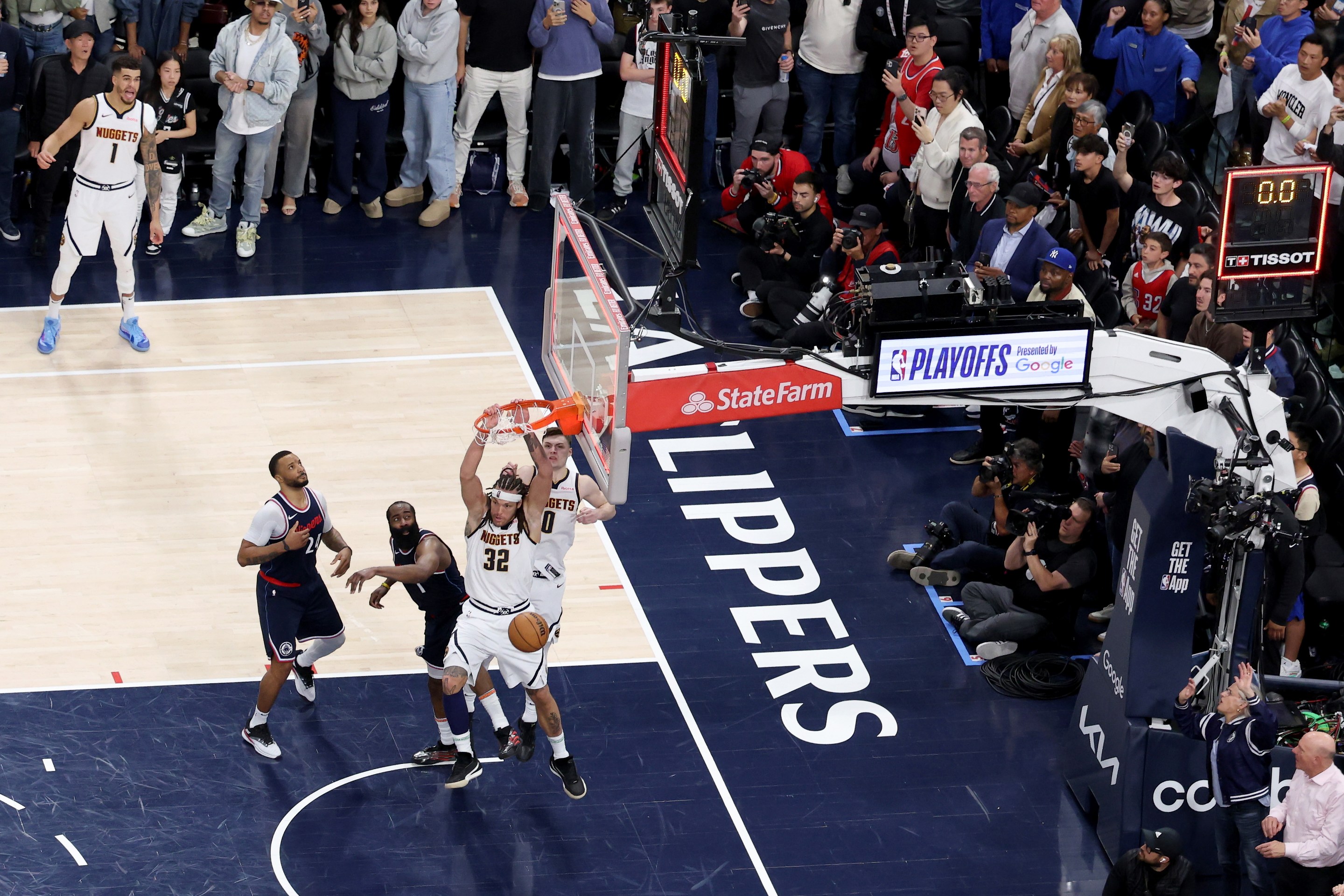It always comes back to Christian Horner and Toto Wolff. This is said with a heavy heart. Well done to Baku; there were interesting moments in spite of Red Bull cruising to an easy 1-2 after Ferrari engines, well, went boom and made a clean sweep of destroying Charles Leclerc, Carlos Sainz, Zhou Guanyu, and Kevin Magnussen's hopes and dreams. McLaren strategists took up the mantle of the missing Ferrari strategists and made the worst possible choices for both of their drivers until no one was happy. Sebastian Vettel dragged the Aston Martin tractor kicking and spinning to P6. Yuki Tsunoda finished the race with his rear wing duct taped together after his DRS flap split down the middle.
If only AlphaTauri showing the world the pinnacle of Formula One engineering were the talking point of the race, we could've enjoyed something that, if perhaps ill-advised, was at least silly to see and fun to talk about. Let's have a little laugh now, in fact. Haha, remember when everyone thought Tsunoda was going to retire from the race but instead the mechanics layered duct tape on his rear wing, NASCAR style? And Jo Bauer, the FIA's Technical Delegate, came stomping down the pit line to try to stop them, only to be reminded that he is only a man and an F1 car is an F1 car as Tsunoda disappeared into the horizon, duct tape flapping in the breeze? Hopefully next week, AlphaTauri will be sporting some duct tape brand's logo on their livery. It's the least they deserve.
Running repairs to Yuki's car 👀#AzerbaijanGP #F1 pic.twitter.com/IQYMLhbGWW
— Formula 1 (@F1) June 12, 2022
Alas, Torger Wolff, Christian Horner, narratives surrounding Mercedes, and unfortunate gaps in FIA safety regulations will remain constant until the heat death of the universe, so instead we will talk about porpoising. Here is an early season example, demonstrated painfully and unfortunately by Charles Leclerc:
Bumpy road to the top for Charles Leclerc! 🤕#F1 pic.twitter.com/Z6a5e6d3bo
— Formula 1 (@F1) February 24, 2022
Chain Bear has a very good technical explanation of the why and how of porpoising. The core issue is that rather than using air running over the car to generate downforce (overbody downforce), the new regulations have prioritized running the air under the car instead (underbody downforce) with the hope that cars would no longer lose downforce due to dirty air, and thus be able to follow more closely and perform more overtakes—in other words, make for more entertaining races. Increased underbody downforce presses the car down until it bottoms out and physically cuts off the airflow generating the downforce. The car's suspension then rises back up, air rushes back in, and the cycle repeats. Combine that with suspension changes and a ban on load-evening inerters—also known as J-dampers thanks to McLaren's super-secret 1997 code-naming—that had been a staple in F1 for decades, and you get the bouncing that Leclerc experiences. The problem with all that bouncing is that it is happening at incredibly high speeds, which can take a brutal physical toll on the drivers.
Eight races into the season, and teams are still struggling with this issue. Baku, a bumpy street track, exacerbated the situation. Before the race, Mercedes driver George Russell urged for discussions addressing porpoising. During the race, Lewis Hamilton said on team radio, "My back is killing me," and the video of him struggling to exit the car afterwards is excruciating to watch. Hamilton's onboards told the same story: The sound of the car floor scraping the ground could be heard over the engine, and the video looked like someone threw a camera in a washing machine.
Wolff, as a team president is wont to do, expressed concern about porpoising, and also suggested that Hamilton may miss next week's race in Canada depending on the severity of his back pain. Cynical minds and Christian Horner alike have suggested that team bosses are encouraging their drivers to complain about the issues to push the FIA to change regulations, rather than simply fix the issues themselves as other teams have done; any rule changes would be unfair to teams that have fixed the issue. (As a side note, Red Bull does not have porpoising issues.) Gosh darn Mercedes skullduggery! Typical Torger Christian "Toto" Wolff manipulation of Formula One regulations! This is just like the time that Mercedes ratted on Red Bull's pitstop procedure and ruined sub-two second pitstops for all of us.
Except it isn't just Mercedes drivers who are complaining about porpoising, and what is being said is concerning for driver health, especially if they continue long-term.
One of Kevin Magnussen's physios, Nikolaj Madsen, speaking on Australia after Monaco: "[Magnussen] talked about how he had some nerve pain going out in his arm and in is his jaw. I talked about it with him and we kind of saw that it was because of the bouncing. The spinal cord just pushed, pushed all the time on the nerves."
Esteban Ocon, after practice in Baku: "The head is all over the place. I felt I was going to lose my helmet at the end of the straight line."
Daniel Ricciardo, after Baku: "It's bad. I genuinely feel rattled. I'm definitely going to help out when people talk about it ... You know when pro basketball players bounce the ball really low? That's what I felt like someone was doing to my helmet."
Etc., etc. It's an incomplete list. But even so, the sentiment isn't universal. After the race, Lando Norris said he felt fine (a discrepancy from his teammate Ricciardo, possibly because of the difference in age and years spent racing) and suggested that Mercedes could fix the issues by raising the ride height of the car, which would cost performance but be easier on the drivers. He isn't wrong. Mercedes, along with other teams on the grid, could solve porpoising issues by raising the car higher off the ground, though that would come at the cost of the car's performance. Wolff, or any other executive, doesn't evoke much sympathy when filing complaints about porpoising and calling for the FIA to change regulations, when an easy solution is there: Raise the ride height. And, at the end of the day, why would Mercedes do that?
Teams will almost always be willing to sacrifice the health of drivers for the performance of the car, and that is not a problem you can fix with duct tape. While teams are unwilling to oblige, the burden of driver safety falls back on the FIA. Carlos Saínz said after practice in Baku, "We kindly asked the FIA to look into [the porpoising], to don’t, let’s say, listen to the teams too much and to listen to us [instead], that we were saying that it’s getting to a point where we are struggling, all of us, to handle this."
The FIA is a historically poor Plan B, unfortunately, but one can dream. It doesn't have to change technical regulations, though porpoising teams and drivers would likely prefer this—drivers are not famously known for their willingness to hemorrhage performance, either. One possible solution is allowing active suspension, but it's likely not a feasible short-term solution for most teams due to development and the spending cap. Mercedes, depending on your sentiments on their engineering capabilities, might have a fancy suspension design up their sleeve and is just waiting for permission to deploy it. A more likely solution may be permitting inerters again, which wouldn't require teams to make a new suspension. There's precedent for technical changes midway through the season: FRIC suspensions were banned midway through 2014, and "party mode" on engines was banned midway through 2020, both changes that hurt Mercedes. If it's unjust, as Horner says, then it's been unjust before.
But the easiest solution is non-technical one. If the FIA is really willing to take steps for driver safety—always a toss-up—it can ban cars from running if drivers experience over a certain amount of G-force from porpoising, or porpoising over a certain amplitude, frequency, and/or duration, forcing teams' hands to sacrifice performance for driver health. It's a bit counterproductive for a racing league to tell cars to slow down, especially considering F1's "fastest cars on the planet" marketing, but c'est la vie. With this solution, almost nobody except for Red Bull will end up happy. And isn't that just in the spirit of the weekend?






